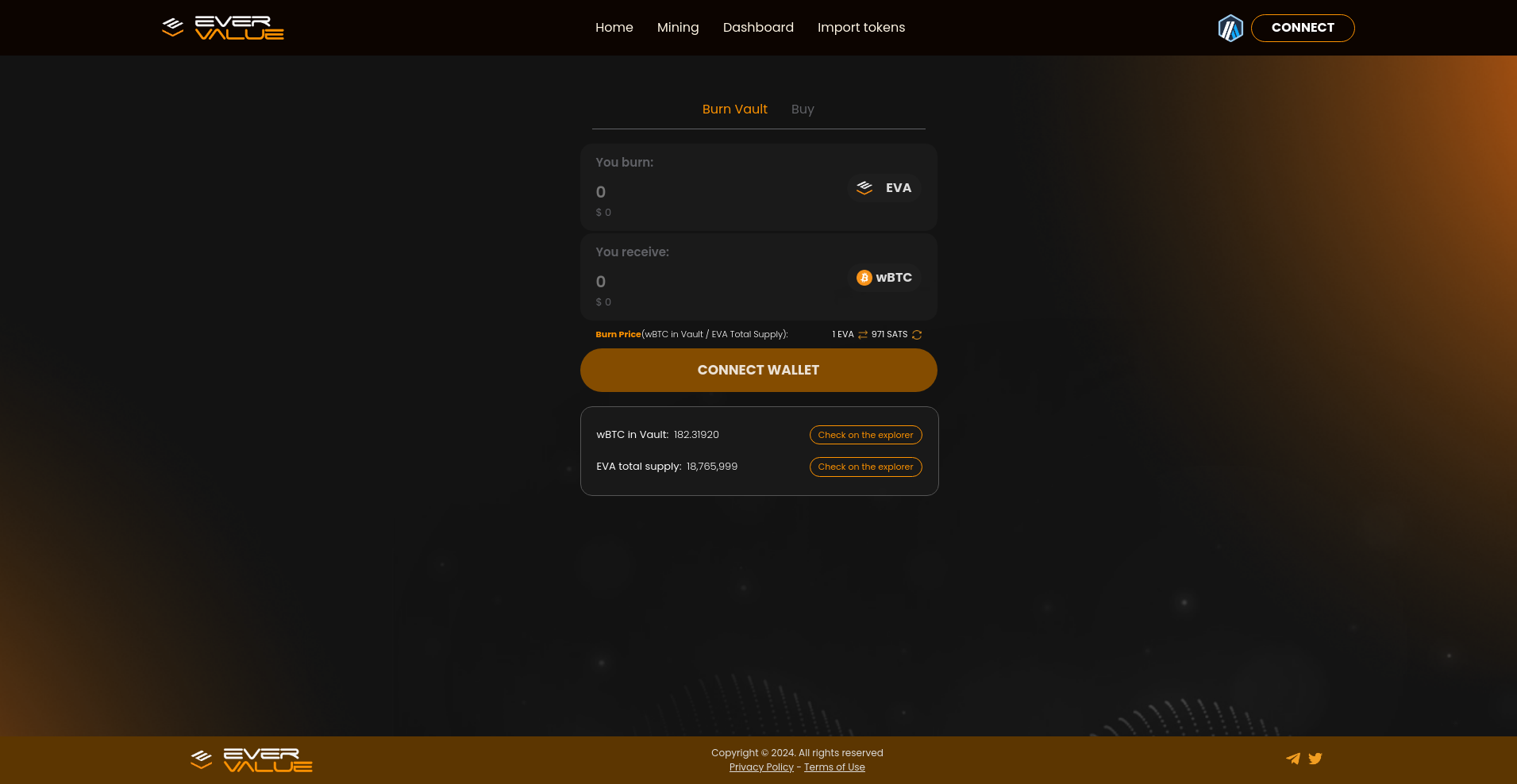EverValue Coin Review: Scam or Legitimate Crypto? Uncovering All The Red Flags

Project Overview
EverValue Coin (EVA) presents itself as a revolutionary cryptocurrency claiming to offer a secure, Bitcoin-backed deflationary token with innovative features like a Burn Vault mechanism. Promising passive gains rooted in Bitcoin mining revenue and a steadily appreciating token in terms of BTC value, the project markets itself as a trustworthy system for long-term growth. However, as investigators committed to crypto due diligence, our role is to scrutinize these claims thoroughly. This article aims to dissect the available data, security audits, tokenomics, and ecosystem activity to determine if EverValue Coin is a viable project or a potential scam with red flags waiting to be uncovered.
Who Is The Team Behind EverValue Coin?
Based on the available summaries, there is little to no transparency concerning the project's core team members. Unlike reputable projects that showcase doxxed founders with verifiable track records, EVA lists only titles such as CEO, Solutions Architect, and Art Director, without linking to personal profiles or past successes. Their roadmap showcases ambitious goals like expanding mining operations, launching new protocols, and engaging media partners by Q3 2025; however, without credible team backgrounds or prior project history, these plans appear overly optimistic, bordering on fantasies rather than grounded, achievable milestones. The lack of transparency raises red flags about credibility and raises questions about who is genuinely behind the project — are they experienced blockchain professionals or anonymous operators attempting to capitalize on Bitcoin hype? The summaries indicate that the only provided details are basic contact info and generic governance statements, which do little to establish authority or accountability.

EverValue Coin Security Audit: A Deep Dive into the Code
The only available security assessment comes from Cer.live, with an audit conducted by Hacken — a reputable firm in blockchain security. The Hacken audit details the smart contract's code on the Arbitrum network, a popular layer-2 solution. Nevertheless, the audit report, linked as a PDF, indicates that while the code was reviewed, incidents of vulnerabilities or severe issues were flagged as "true" or “present,” suggesting that existing code may have security concerns that need fixing. The audit does not show a perfect score; with a rating of 8.2 out of 10, there are minor bugs or improvements noted, but no critical flaws are explicitly disclosed. Such a score is acceptable but warrants caution — a perfect security record absent from the report. Furthermore, the project conducts ongoing audits, yet there's little public evidence of incident resolution, and the fact that they rely primarily on security firm assessments means the code may still harbor undisclosed or unpatched vulnerabilities.

Analyzing the EverValue Coin Tokenomics: Supply, Distribution, and Risks
The tokenomics heavily emphasize a ceremonial total supply of 21 million EVA tokens, mirroring Bitcoin's scarcity. The initial allocation is 90% to investors, with only 10% reserved for founders and team members, which seems reasonable on paper. The project claims that the "Burn Vault" holds 70% of tokens for backing through BTC deposits, with additional allocations for mining infrastructure, marketing, and liquidity pools — each share small, yet the real question is about utility and sustainability. The immense reliance on the burn and redemption mechanism, which involves burning EVA tokens to withdraw wBTC, poses inherent risks: if a large number of investors decide to exit simultaneously, the system could face a sell-off, diminishing backing and undermining value appreciation. Moreover, given the opaque nature of the project's operations, there's little transparency on team allocation, vesting periods, or lock-up terms, which could lead to dumping or inflationary pressures once initial hype fades.
Ecosystem and Development Activity: Ghost Town or Growing Venture?
The summaries reveal a flow of marketing and roadmap promises, including onboarding exchange listings, launching new protocols like loan systems, and expanding community engagement via social media. However, actual activity seems limited. The presence of placeholders like "Mining Income History," "Burn Vault," and "Tokenomics" sections on their platform suggest ongoing development, but no verifiable proof of consistent project updates, active development repositories, or real-world milestones achieved. The last official news mentions presale success and media coverage, yet no evidence points to massive ongoing activity or sustained product deployment. The roadmap's ambitious timeline from Q1 2024 through beyond Q3 2025 lacks confirmation of deliverables, raising concerns about the project's genuine progress on technical or ecosystem fronts.
The Fine Print: What Do Legal Documents Reveal?
Legal and privacy policy summaries demonstrate standard compliance with data protection laws, but contain typical legal jargon with no unusual clauses. Notably, there is no mention of user rights, dispute resolution, or explicit disclaimers that could indicate predatory intentions. However, the absence of disclosures about fees, exit policies, or risk warnings is troubling. Projects designed with red flags often omit critical legal specifics to obscure potential downsides or liabilities from investors. Also, the fact that all content is hosted on a standard website with no verified licensing, licensing exemptions, or regulatory licenses raises questions about their legal status, especially when promising high-yield passive income via Bitcoin mining — a highly scrutinized activity in many jurisdictions.
Final Verdict: Should You Risk Investing in EverValue Coin?
- Red Flags:
- Opaque team with no publicly verifiable identities or past successes.
- Limited public proof of genuine ongoing development or ecosystem expansion.
- Initial security score indicates minor vulnerabilities that may be exploitable.
- Heavy reliance on promises of BTC appreciation and allegedly "guaranteed" returns without clear operational transparency.
- Absence of a clear legal framework or regulatory compliance information.
- Possible Positives:
- Smart contract audit conducted by reputable firm, with no critical vulnerabilities publicly disclosed.
- Tokenomics mimics Bitcoin scarcity, potentially attractive to serious BTC holders.
- Attention to security policies and transparency in some project documentation.
Despite some points of merit, the numerous red flags — anonymous team, unverified progress, and reliance on unconfirmed profit guarantees — suggest extreme caution. Potential investors should perform comprehensive due diligence, seek transparency about the team, and be wary of promises that sound too good to be true. Always remember that in the crypto space, lack of transparency often correlates with high risk and potential scams.

Christopher Anderson
Smart Contract Auditor & Legal Tech Analyst
I have a dual background in law and computer science. I audit smart contracts to find the critical gap between a project's legal promises and its code's reality.
Similar Projects
-
FlipFox
FlipFox Review: Scam or Legit Crypto? Scam Check & Analysis
-
Orygyn Finance
Orygyn Finance ($YIN) Review: Risks and Project Analysis
-
POKE6900
In-Depth Review of POKE6900 Crypto Project: Scam or Legit? Crypto Scam Checker & Review
-
Cipher (CPR)
Crypto Project Review & Scam Checker: Is Cipher (CPR) Legit or a Scam in 2025?
-
FlashWash
FlashWash Review: Comprehensive Crypto Project Scam Checker